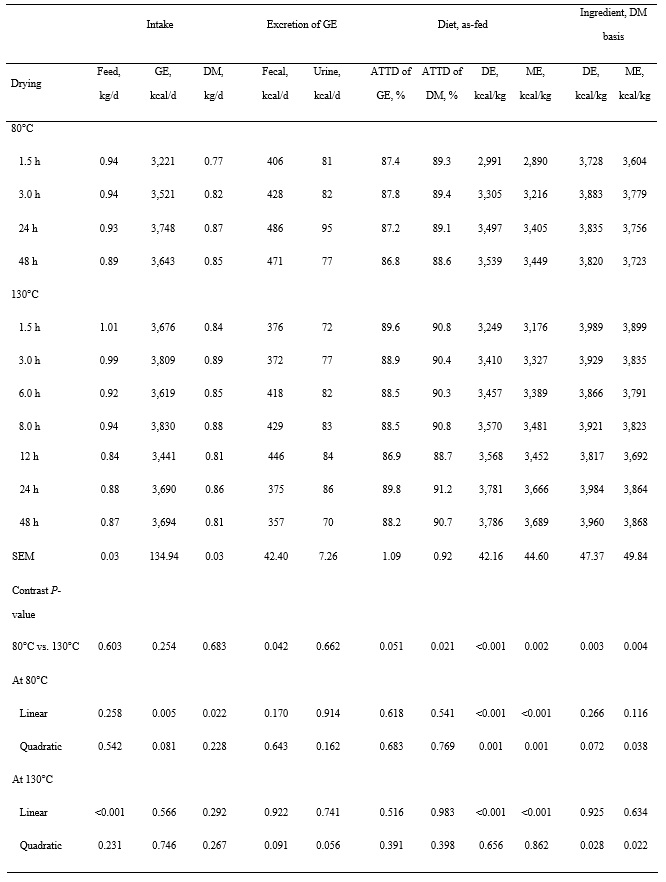Corn is harvested at a high moisture level, and thus must be dried to less than 15% moisture to ensure safe storage. Improvements to reduce the energy consumption of the dryers have been implemented, especially by increasing the inlet air temperature. However, overheating may have a negative impact on the stability of nutrients, especially amino acids (AA), because Maillard reactions may occur if heat and moisture are applied to feed ingredients. Consequently, Maillard reactions result in a decrease in the concentration and digestibility of AA, and it is possible that energy digestibility is also reduced. Therefore, the objective of these experiments was to test the hypothesis that both the temperature used in drying and the time that heat is applied will affect the standardized ileal digestibility (SID) of AA, and concentration of digestible energy (DE) and metabolizable energy (ME) in corn fed to growing pigs.
Animals, Housing, Experimental design, and diets
Two experiments were conducted and the Institutional Animal Care and Use Committee at the University of Illinois reviewed and approved the protocols for both experiments. Pigs used in both experiments were the offspring of Line 800 boars mated to Camborough females (Pig Improvement Company, Hendersonville, TN). The corn used in both experiments originated from a single source, which was divided in 11 batches that were dried using a “drying chamber” at 80ºC for 1.5, 3.0, 24, or 48 h or at 130ºC for 1.5, 3.0, 6.0, 9.0, 12, 24, or 48 h.
Experiment 1 was designed to determine the concentrations of DE and ME in the 11 batches of corn. Eleven diets based on each batch of corn were formulated. Eighty-eight growing barrows (20.6 ± 1.2 kg) were allotted to the 11 diets in a randomized complete block design with 8 blocks of 11 pigs. Urine and fecal samples were collected for 4-days after 7-days of adaptation. Gross energy and dry matter were analyzed in diets, ingredients, fecal and urine samples, and the ATTD was calculated. Values for digestible energy (DE) and metabolizable energy (ME) were calculated as well.
Experiment 2 was designed to determine the SID of AA in the 11 batches of corn. An N-free diet and 11 diets that each contained one of the 11 batches of corn as the sole source of AA were formulated. All diets contained 0.40% chromic oxide as an indigestible marker. Twenty-four growing pigs (22.8 ± 5.1 kg) that had a T-cannula installed in the distal ileum were allotted to a replicated 12 × 4 Youden square with 12 diets and four 7-day periods in each square. Therefore, there were 8 replicate pigs per diet. Ileal digesta were collected on days 6 and 7 of each 7-days period. Diets, ingredients, and ileal digesta samples were analyzed for dry matter, crude protein, and amino acids. Standardized ileal digestibility of crude protein and AA were calculated for the 11 diets containing corn as previously described (Stein et al., 2007). The basal endogenous losses of CP and AA were calculated from pigs fed the N-free diet. Values calculated for these 11 diets also represent the values for each ingredient.
Results
No differences were observed in daily feed intake, daily energy intake, and daily dry matter intake between diets containing corn dried at 80 ºC or 130 ºC (Table 1), but the daily feed intake decreased (linear, P < 0.01) as the duration of drying increased at 130ºC. In contrast, daily energy intake and dry matter intake increased (linear, P < 0.01) as the duration of drying increased at 80ºC. The ATTD of DM and GE was greater (P ≤ 0.05) in diets containing corn dried at 130ºC than in diets containing corn dried at 80ºC. The ME (dry matter basis) was greater (P < 0.01) if corn was dried at 130ºC than at 80ºC (Table 1). The ME (dry-matter basis) increased (quadratic, P < 0.04) with drying time at 80ºC, whereas it decreased at 130°C (quadratic, P < 0.05). The SID of AA did not differ between corn dried at 80°C and 130°C, except that the SID of Lys was less (P < 0.05) if corn was dried at 130°C than at 80°C (Table 2). The SID of most AA decreased (linear or quadratic, P < 0.05) as time of drying increased at 130°C.
Key points
- Corn heat dried at 80°C does not affect the SID of AA, and improved ME values as the duration of drying increased.
- Corn heat dried at 130°C reduces the concentrations of AA, especially Lys, which resulted in decreases the SID of AA and ME values.
- These results indicate that corn heat dried at 130°C resulted in damage of AA due to Maillard reactions, in which Lys is the most reactive AA.
Table 1. Apparent total tract digestibility of GE and DM, and concentrations of DE and ME in heat dried corn, experiment 11

1Data are least squares means of 6 or 8 observations per treatment.
Table 2. Standardized ileal digestibility (%) of crude protein and AA in heat dried corn1, experiment 2

1Data are least squares means of 7 or 8 observations per treatment.